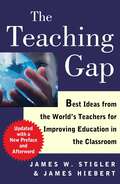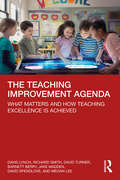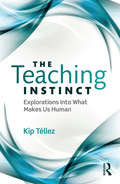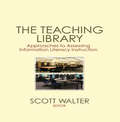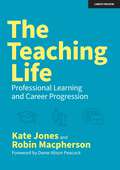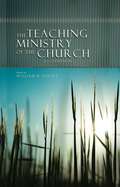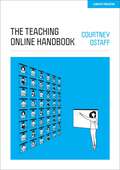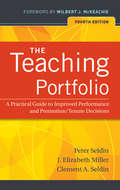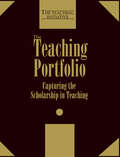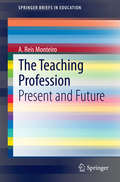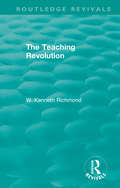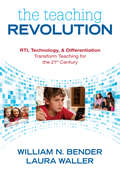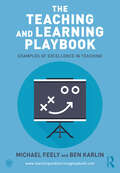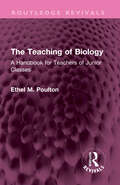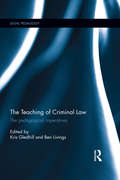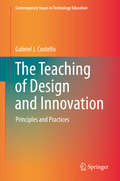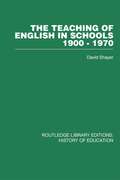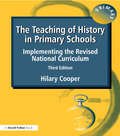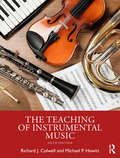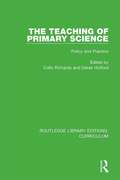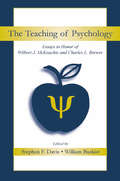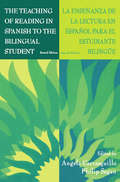- Table View
- List View
The Teaching Gap: Best Ideas from the World's Teachers for Improving Education in the Classroom
by James W. Stigler James HiebertComparing math teaching practices in Japan and Germany with those in the United States, two leading researchers offer a surprising new view of teaching and a bold action plan for improving education inside the American classroom. For years our schools and children have lagged behind international standards in reading, arithmetic, and most other areas of academic achievement. It is no secret that American schools are in dire need of improvement, and that education has become our nation's number-one priority. But even though almost every state in the country is working to develop higher standards for what students should be learning, along with the means for assessing their progress, the quick-fix solutions implemented so far haven't had a noticeable impact. The problem, as James Stigler and James Hiebert explain, is that most efforts to improve education fail because they simply don't have any impact on the quality of teaching inside classrooms. Teaching, they argue, is cultural. American teachers aren't incompetent, but the methods they use are severely limited, and American teaching has no system in place for getting better. It is teaching, not teachers, that must be changed. In The Teaching Gap, the authors draw on the conclusions of the Third International Mathematics and Science Study (TIMSS) -- an innovative new study of teaching in several cultures -- to refocus educational reform efforts. Using videotaped lessons from dozens of randomly selected eighth-grade classrooms in the United States, Japan, and Germany, the authors reveal the rich, yet unfulfilled promise of American teaching and document exactly how other countries have consistently stayed ahead of us in the rate their children learn. Our schools can be restructured as places where teachers can engage in career-long learning and classrooms can become laboratories for developing new, teaching-centered ideas. If provided the time they need during the school day for collaborative lesson study and plan building, teachers will change the way our students learn. James Stigler and James Hiebert have given us nothing less than a "best practices" for teachers -- one that offers proof that how teachers teach is far more important than increased spending, state-of-the-art facilities, mandatory homework, or special education -- and a plan for change that educators, teachers, and parents can implement together.
The Teaching Improvement Agenda: What Matters and How Teaching Excellence Is Achieved
by David Lynch Richard Smith Barnett Berry David Turner David Spendlove Megan Lee Jake MaddenDrawing on ten years of research into whole-of-school teaching improvement, this engaging text explains what teaching improvement requires, how it is achieved, and how to maintain it in your classroom and school.Based on studies involving real schools and real teachers, The Teaching Improvement Agenda is focused on what really matters for teachers and leaders in today’s schools. The book begins with an examination of the education field to identify the fundamental elements which inform and generate teaching improvement. This lays the foundations for an instructive set of innovative, research-informed strategies which have been designed to empower the teacher and school leader to improve teaching across the whole school. The book closes with a series of case studies that demonstrate these approaches in action.Answering the "what?" and "how?" questions of teaching improvement, this book is an essential guide for school leaders and teachers, as well as instructors and students in initial teacher education.
The Teaching Instinct: Explorations Into What Makes Us Human
by Kip TéllezHow we select, prepare, and support teachers has become a surprisingly common topic among journalists, politicians, and policymakers. Contemporary recommendations on teaching and teachers, whatever their intentions, fail to assess this deeply human activity from its historical roots. In The Teaching Instinct: Explorations Into What Makes Us Human, Kip Téllez invites us to reappraise teaching through a wide lens and argues that our capacity to teach is one part culture, two parts genetic. By rescuing the field of instinct psychology from the margins, this challenging book explores topics as diverse as teaching in other species, teaching across human cultures, and the development of teaching in young children, finally drawing readers into a discussion about how our teaching instinct influences modern teacher learning, selection, and preparation. Drawing on disciplines as diverse as comparative biology, evolutionary psychology, and teacher education policy, Téllez warns us that ignoring or contradicting our teaching instinct results in unhappy teachers and dysfunctional school systems.
The Teaching Library: Approaches to Assessing Information Literacy Instruction
by Scott WalterGet the information needed to advocate for the significance of your library! How do you make the case that your library is a valuable instruction center? The Teaching Library helps librarians assess data on information literacy instruction programs so that they can better support the teaching role of the academic library in campus settings. This practical, professional resource features case studies from across the United States and Canada-in both public and private institutions-that offer a variety of evaluation methods. Here are the latest, easy-to-adopt ways of measuring your library&’s direct contribution to student learning, on-campus and off. With a unique multifaceted approach to questions of assessment, The Teaching Library is an important resource that not only offers the latest techniques, but answers the larger question of how to make use of this data in ways that will best advocate information literacy instruction programs. From creating a multidimensional assessment to turning an initiative into a program to teaching and learning goals and beyond, this invaluable text covers many of the core issues those in this rapidly-evolving field must contend with. These contributions reinforce the importance of the learning that takes place in the classroom, in the co-curriculum, the extra-curriculum, and the surrounding community. Some of the key topics covered in The Teaching Library are: assessment practices such as 360° analysis, attitudinal, outcomes-based, and gap-measured integrating the teaching library into core mission, vision, and values statements presenting the message of a library&’s value to internal audiences of colleagues building momentum-and maintaining it tying information literacy assessment to campus-wide assessment activities identifying and reaching end-of-program learning outcomes assessing the impact of the one-shot session on student learning information literacy instruction and the credit-course model promoting instruction among Library and Information Science educators and many more! The essays in The Teaching Library offer viable and practical ways for librarians to demonstrate their direct contribution to student learning in ways consistent with those accepted as valid across the campus. An important resource for academic librarians and Information Science professionals, The Teaching Library is also a useful tool for those in the campus community concerned with developing, funding, and continuing successful library programs-professional staff such as alumni directors; faculty and educators looking to make students more successful; and researchers.
The Teaching Life: Professional Learning and Career Progression
by Kate Jones Robin MacphersonBeing a teacher is far from easy. Being the best teacher you can be is even tougher. There are two really important things that every teacher needs to get right so that they feel fulfilled and challenged in what they do. Firstly, they need to continually develop their craft through effective professional learning. Secondly, they need to map out a career path that has progression as its defining feature. There are very few people who manage to do both things well. Education doesn’t stand still, so being a good teacher means being in a constant state of evolution. How do we achieve this? Covering the latest developments in professional learning, Kate Jones and Robin Macpherson explore the massive changes that the global pandemic has brought, seeing it as a paradigm shift with manifest opportunities. The corollary to this is career progression, which is really about making the right professional choices. Are you a one school person for your whole time in teaching? Do you change location or role? Do you harbour leadership ambitions? And crucially, how do you finish your career on a high? Working out what you want to achieve in your teaching life is a core focus of the book, and is addressed through a range of interviews, case studies, and challenge questions. It is not about telling you what to do but prompting you to reflect on what you do.The Teaching Life is for anyone who wants to make the most of their time in education, for their students and for themselves.
The Teaching Life: Professional Learning and Career Progression
by Kate Jones Robin MacphersonBeing a teacher is far from easy. Being the best teacher you can be is even tougher. There are two really important things that every teacher needs to get right so that they feel fulfilled and challenged in what they do. Firstly, they need to continually develop their craft through effective professional learning. Secondly, they need to map out a career path that has progression as its defining feature. There are very few people who manage to do both things well. Education doesn’t stand still, so being a good teacher means being in a constant state of evolution. How do we achieve this? Covering the latest developments in professional learning, Kate Jones and Robin Macpherson explore the massive changes that the global pandemic has brought, seeing it as a paradigm shift with manifest opportunities. The corollary to this is career progression, which is really about making the right professional choices. Are you a one school person for your whole time in teaching? Do you change location or role? Do you harbour leadership ambitions? And crucially, how do you finish your career on a high? Working out what you want to achieve in your teaching life is a core focus of the book, and is addressed through a range of interviews, case studies, and challenge questions. It is not about telling you what to do but prompting you to reflect on what you do.The Teaching Life is for anyone who wants to make the most of their time in education, for their students and for themselves.
The Teaching Ministry of the Church (Second Edition)
by William YountThe second edition of The Teaching Ministry of the Church makes a major overhaul of its predecessor, increasing the content from eighteen to twenty three chapters and contributors from six to thirteen. These writers assert the need for such an expanded update is due to our everchanging world. For example, the rise of Islamic fundamentalism, proliferation of religious sects, and secularization of our culture greatly increase the importance of ensuring the church produces fully developed, biblically informed followers of Jesus. To that end, The Teaching Ministry of the Church presents a full overview of Christian education in four major sections: Theological Foundations, Biblical Foundations, Preparation for Teaching, and Structuring the Teaching Ministry of the Church. Within this framework, a step-by-step plan for establishing and maintaining an effective teaching ministry among preschoolers, children, youth, and adults takes shape. Key chapters: "The Bible as Curriculum," "The Church's Role in Teaching," "Creating an Unforgettable Learning Experience," and "Equipping Teachers. "
The Teaching Online Handbook
by Courtney OstaffClassroom teachers are increasingly expected to teach online – creating content area courses from scratch with little support or training. But high-quality, researched-based online teaching has its own particular set of skills and expectations, and most resources are directed at college-level instructors. This no-nonsense handbook is for that busy classroom teacher, with clear techniques for planning, instruction, and assessment, as well as sections on teaching students with diverse needs and exceptionalities. Based on the author's real-life experiences as an online teacher, there are multiple examples including sample assignments across content areas, rubrics for grading, and sample scripts for parent contact as well as tips to reduce instructor workload and conduct successful live instruction.
The Teaching Online Handbook
by Courtney OstaffClassroom teachers are increasingly expected to teach online – creating content area courses from scratch with little support or training. But high-quality, researched-based online teaching has its own particular set of skills and expectations, and most resources are directed at college-level instructors. This no-nonsense handbook is for that busy classroom teacher, with clear techniques for planning, instruction, and assessment, as well as sections on teaching students with diverse needs and exceptionalities. Based on the author's real-life experiences as an online teacher, there are multiple examples including sample assignments across content areas, rubrics for grading, and sample scripts for parent contact as well as tips to reduce instructor workload and conduct successful live instruction.
The Teaching Portfolio
by J. Elizabeth Miller Peter Seldin Wilbert Mckeachie Clement A. SeldinThoroughly revised and updated, this fourth edition of the classic hands-on resource offers a comprehensive review of all the facets developing teaching portfolios. This new edition will contain new perspectives and ideas; an expanded section on web-based electronic teaching portfolios ; a sample of colleges and universities that shows how they have implemented portfolios; real-world teaching portfolios of twenty-one faculty members and a report from a university provost on what he looks for in a portfolios submitted for promotion.
The Teaching Portfolio: Capturing the Scholarship in Teaching
by Russell Edgerton Patricia Hutchings Kathleen QuinlanThis valuable work suggests one model in which faculty assemble a collection of carefully selected work samples accompanied by reflective commentary about them. Covers the what, why, and how of teaching portfolios, with pointers for getting started and a sampling of current campus practices. Includes reproductions of eight actual portfolio entries. The companion volume toCampus Use of the Teaching Portfolio.
The Teaching Profession
by A. Reis MonteiroThis volume contributes to debates about the teaching profession by reviewing international and national reports on its status, as well as on reforms of various education systems. It proposes a global approach to the quality of the teaching profession as a decisive ingredient of education quality, including a conception of its identity and a vision of its future. Moreover, it is suggested that professional self-regulation may be the best way to achieve higher professional and social status for teachers, since it allows educators collectively to assume the culture of the values that comprise the uniqueness and fullness of the teaching profession.
The Teaching Revolution (Routledge Revivals)
by W. Kenneth RichmondOriginally published in 1967, education had entered a period of fundamental change. The developments described in this book – team-teaching, audio-visual aids, programmed learning, curriculum reform projects, and the like – had tended to progress in isolation from each other, and only recently had it been realized how much they had in common. Today it can be read and enjoyed in its historical context.
The Teaching Revolution: RTI, Technology, and Differentiation Transform Teaching for the 21st Century
by William N. Bender Laura B. WallerImagine the school of the future! The Teaching Revolution provides a futuristic and provocative discussion on the combining of three major instructional innovations—RTI, technology, and differentiation. Drawing on the growing 21st-century skills movement, the text engagingly weaves these three areas with a vision for school transformation that includes: Utilizing mobile technologies, web-based instruction, and social media RTI that benefits all students and whole schools in their improvement efforts Project-based learning focused on answering real-world questions The Teaching Revolution will dare you to dream and guide you through the process of transforming education to become all that you can imagine.
The Teaching and Learning Playbook: Examples of Excellence in Teaching
by Ben Karlin Michael FeelyThe Teaching and Learning Playbook is a book and online resource containing more than 100 techniques that teachers and school leaders can use to drive improvements in their schools. Each technique includes a summary of what the technique is, why it is important, the effect size and a four-step guide to how it should be performed. The Playbook provides a unique tool for teachers to identify how they can improve their teaching, and practise with absolute clarity on what they need to do next. All techniques are accompanied by a video to show the technique in action and spotlight the four key elements with detailed audio commentary to make it easier for teachers to replicate. These can all be found on the website: www.teachingandlearningplaybook.com Codifying the key skills for every teacher to get better and for every school leader to drive improvements in their school, the Playbook covers: • Routines for Learning; • Questioning and Checking for Understanding; • Modelling, Explaining and Feeding Back; • Resilience, Independence and Retrieval; • Curriculum; • Beyond the Subject Classroom. This essential resource provides a clear framework for teachers and school leaders to improve teaching and learning. Simple to use and easily integrated into CPD and coaching programmes, the Playbook will take your teaching to the next level.
The Teaching of Biology: A Handbook for Teachers of Junior Classes (Routledge Revivals)
by Ethel M. PoultonFirst published in 1931, the original blurb reads: "A practical handbook for those who are engaged in teaching elementary biology (Nature Study) to children of 10-13 years. Part I is devoted to general methods of teaching the subject. Part II consists of subject matter suitable for lessons, together with suggestions as to practical work and classroom procedure." It was hoped that this work would help the move away from the tradition, still prevalent at the time, where observation of minute details and absence of associated physiological work left the children with little interest in the subject. This book would contribute to a type of teaching where more regard was paid to the ‘livingness’ of the organism, resulting in the deepening of the pupil’s enjoyment of the beauty of animate nature. Today it can be read in its historical context.
The Teaching of Criminal Law: The pedagogical imperatives (Legal Pedagogy)
by Kris Gledhill Ben LivingsThe Teaching of Criminal Law provides the first considered discussion of the pedagogy that should inform the teaching of criminal law. It originates from a survey of criminal law courses in different parts of the English-speaking world which showed significant similarity across countries and over time. It also showed that many aspects of substantive law are neglected. This prompted the question of whether any real consideration had been given to criminal law course design. This book seeks to provide a critical mass of thought on how to secure an understanding of substantive criminal law, by examining the course content that best illustrates the thought process of a criminal lawyer, by presenting innovative approaches for securing active learning by students, and by demonstrating how criminal law can secure other worthwhile graduate attributes by introducing wider contexts. This edited collection brings together contributions from academic teachers of criminal law from Australia, New Zealand, the United Kingdom, and Ireland who have considered issues of course design and often implemented them. Together, they examine several innovative approaches to the teaching of criminal law that have been adopted in a number of law schools around the world, both in teaching methodology and substantive content. The authors offer numerous suggestions for the design of a criminal law course that will ensure students gain useful insights into criminal law and its role in society. This book helps fill the gap in research into criminal law pedagogy and demonstrates that there are alternative ways of delivering this core part of the law degree. As such, this book will be of key interest to researchers, academics and lecturers in the fields of criminal law, pedagogy and teaching methods.
The Teaching of Criminal Law: The pedagogical imperatives (Legal Pedagogy)
by Kris Gledhill Ben LivingsThe Teaching of Criminal Law provides the first considered discussion of the pedagogy that should inform the teaching of criminal law. It originates from a survey of criminal law courses in different parts of the English-speaking world which showed significant similarity across countries and over time. It also showed that many aspects of substantive law are neglected. This prompted the question of whether any real consideration had been given to criminal law course design. This book seeks to provide a critical mass of thought on how to secure an understanding of substantive criminal law, by examining the course content that best illustrates the thought process of a criminal lawyer, by presenting innovative approaches for securing active learning by students, and by demonstrating how criminal law can secure other worthwhile graduate attributes by introducing wider contexts. This edited collection brings together contributions from academic teachers of criminal law from Australia, New Zealand, the United Kingdom, and Ireland who have considered issues of course design and often implemented them. Together, they examine several innovative approaches to the teaching of criminal law that have been adopted in a number of law schools around the world, both in teaching methodology and substantive content. The authors offer numerous suggestions for the design of a criminal law course that will ensure students gain useful insights into criminal law and its role in society.This book helps fill the gap in research into criminal law pedagogy and demonstrates that there are alternative ways of delivering this core part of the law degree. As such, this book will be of key interest to researchers, academics and lecturers in the fields of criminal law, pedagogy and teaching methods.
The Teaching of Design and Innovation: Principles and Practices (Contemporary Issues in Technology Education)
by Gabriel J. CostelloThis book is about design and innovation – what it is and how to teach it. The blending of design and innovation is having an increasing impact not only on the world of products and services but on a wide variety of disciplines such as information and communications technology (ICT), business, education and medicine. However, there is a lack of books on teaching the subject despite the significant growth of interest in both academia and the workplace. This book addresses this gap by outlining foundational principles for the teaching of design and innovation and by offering a practical process for implementing the pedagogy in academic institutions and outside academia in the context of continuing professional development (CPD). It describes two undergraduate case-studies that aimed to instill design and innovation competences in students of both engineering and business disciplines. The cases involved student teams working with incubation centre start-ups and multi-national subsidiaries. One of the aims of this book is to provide a resource for continuing professional development (CPD). Consequently, a third practitioner-based case study is presented as an example of research-informed teaching. In addition, the book proposes the concept of Simulation-Action Learning (SAL) as an enhancement of Project-Based Learning (PBL).
The Teaching of English in Schools: 1900-1970
by David ShayerOriginally published in 1972. 1900-1970 saw extensive changes in the teaching of English in schools. The volume studies English instruction as it developed at junior and secondary level over this period. Using textbooks, method books, Board and Ministry Reports and other contemporary opinion, the book examines the basic questions arising from this historical survey. Whilst the main emphasis is on changes in actual classroom methods, the volume also examines the wider social pressures which have modified the school system in the UK as well as English as a subject in that system.
The Teaching of History in Primary Schools: Implementing the Revised National Curriculum
by Hilary CooperFirst Published in 2001. Routledge is an imprint of Taylor & Francis, an informa company.
The Teaching of Instrumental Music
by Richard J. Colwell Michael P. HewittThe Teaching of Instrumental Music, Sixth Edition, introduces music education majors to basic instrumental pedagogy for the instruments and ensembles commonly found in the elementary and secondary curricula. It focuses on the core competencies required for teacher certification in instrumental music, with the pervasive philosophy to assist teachers as they develop an instrumental music program based on understanding and respecting all types of music.Parts I and II focus on essential issues for a successful instrumental program, presenting first the history and foundations, followed by effective strategies in administrative tasks and classroom teaching. Parts III, IV, and V are devoted to the skills and techniques of woodwind, brass and percussion, and string instruments. In all, The Teaching of Instrumental Music is the complete reference for the beginning instrumental teacher, commonly retained in a student’s professional library for its unique and comprehensive coverage.This Sixth Edition includes: Streamlined language and improved layout throughout, making this edition more concise and accessible to students. Updated content throughout, including insights from current research for curriculum development, coverage of current law and policy changes that impact the classroom, contemporary motivational strategies, and more information on the history of African-American and all-female music ensembles. Updated references, photos, lists of artists, and online resources.
The Teaching of Primary Science: Policy and Practice (Routledge Library Editions: Curriculum #29)
by Colin Richards Derek HolfordOriginally published in 1983. This book provides the first overview of developments in primary science prior to and following the national survey of primary schools in 1978. Key issues central to contemporary policy and practice are identified, set in context and interrelated for teachers, students, tutors and policymakers. Contributors to the book include most of the leading figures in contemporary primary science at the time.
The Teaching of Psychology: Essays in Honor of Wilbert J. McKeachie and Charles L. Brewer
by Stephen F. Davis William BuskistThe Teaching of Psychology is centered around the masterful work of two champions of the teaching of psychology, Wilbert J. McKeachie and Charles L. Brewer, in order to recognize their seminal contributions to the teaching of the discipline. The book's main goal is to provide comprehensive coverage and analysis of the basic philosophies, current issues, and the basic skills related to effective teaching in psychology. It transcends the typical "nuts and bolts" type books and includes such topics as teaching at small colleges versus a major university, teaching and course portfolios, the scholarship of teaching, what to expect early in a teaching career, and lifelong learning.The Teaching of Psychology also features: Biographies of Bill McKeachie and Charles L. Brewer Fourteen chapters written by leading authorities in the teaching of psychology, which provide overviews of the latest psychological research and theories in effective college and university teaching. These chapters cover lecturing, classroom presence, using humor in teaching, pedagogy, advising, teaching critical thinking, writing, and technology, and training graduate students to teach Useful advice to new teachers and seasoned veterans, including qualities of master teachers, understanding the many facets of working within the academy, and teaching with technology Insights into teaching specific courses within the psychology curriculum, including the history of psychology, biological psychology, statistics and research methods, learning, social psychology, personality, psychology of women, cross-cultural psychology, industrial/organizational psychology, psychology of religion, and environmental psychology A closing section containing Bill McKeachie's and Charles L. Brewer's perspectives into the teaching of psychology and its history, highlights, and future. This book is intended for academic psychologists who teach and/or train graduate assistants to teach at the college and university level. All royalities from this book will be donated to the Society for the Teaching of Psychology (Division 2 of the American Psychological Association), which each year sponsors many activities across the country to promote the teaching of psychology.
The Teaching of Reading in Spanish to the Bilingual Student: La Ense¤anza De La Lectura En Espa¤ol Para El Estudiante Biling e
by Angela Carrasquillo Philip SeganThis dual-language text provides theory and methodology for teaching reading in Spanish to Spanish/English bilingual or Spanish-dominant students. The goal is to help educators teach these students the skills necessary to become proficient readers and, thus, successful in the school system. At the very core of the book are the hispano-parlantes--the Spanish-speaking children--who bring to the schools, along with their native language and cultures, a wealth of resources that must be tapped and to whom all educators have a responsibility to respond. True to the concepts of developing bilingual educators to serve bilingual students, the text presents chapters in English and Spanish. Each chapter is written in only one language at the preference of the author. Thus, to be successful with this book, the reader must be bilingual. Themes emphasized in the text include current reading methodologies, the concept of reading as developmental literacy skills, reading in the content areas, new views of the development of proficiency in the second language, issues related to students with special learning needs, assessment, and the uses of technology in the delivery of instruction. Never losing sight of its goal--to teach reading in Spanish to bilingual or Spanish-dominant students--the book includes a series of focusing questions and follow-up activities; these are not simply translations of existing activities, strategies, and techniques intended for monolingual English students, but specifically designed to be appropriate for Spanish-speaking students. Directed to university preservice and in-service instructors of reading and bilingual education as well as administrators and district- and school-level staff developers who work with Hispanic populations, the book is sensitive at all times to nuances of the languages and cultures of the intended audiences.
